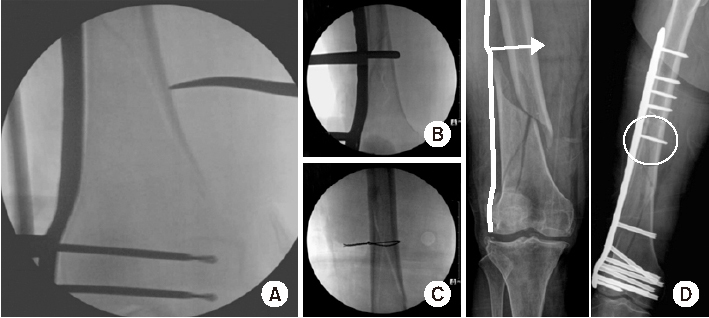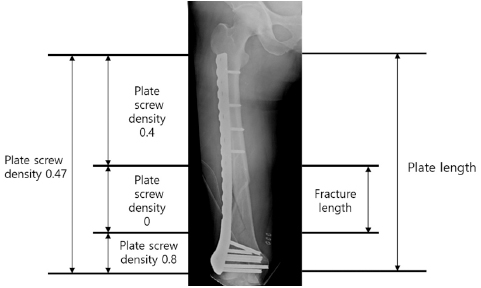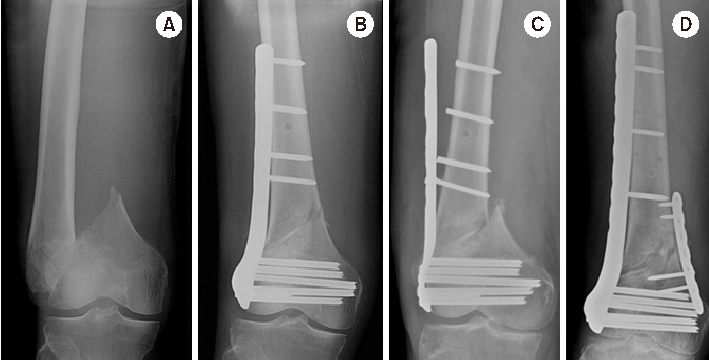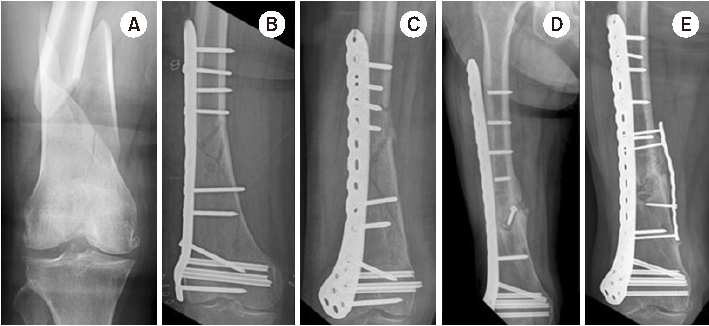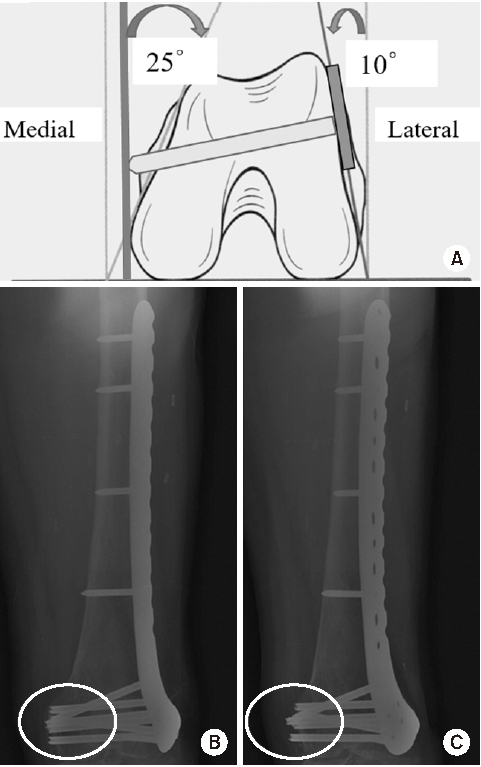J Korean Fract Soc.
2019 Apr;32(2):112-119. 10.12671/jkfs.2019.32.2.112.
Locked Plating in Elderly Patients with Distal Femur Fracture: How to Avoid Complications?
- Affiliations
-
- 1Department of Orthropaedic Surgery, Hallym University Sacred Heart Hospital, Anyang, Korea. oships@hallym.ac.kr
- KMID: 2443114
- DOI: http://doi.org/10.12671/jkfs.2019.32.2.112
Abstract
- Distal femur fractures in elderly patients with osteoporosis are complicated because poor bone quality makes screw purchase and fixation less secure, presenting many clinical challenges to the orthopedic surgeon. Minimally invasive locked plating using an angularly stable locking compression plate has become an integral tool for achieving secure fixation in osteoporotic distal femur fractures with improved biomechanical performance. On the other hand, complications, such as implant failure and periplate fracture, have still occurred. This paper describes the principles of internal fixation in minimally invasive lateral locked plating in elderly patients with osteoporotic distal femur fractures as well as how to avoid complications.
Figure
Reference
-
1. Krettek C, Müller M, Miclau T. Evolution of minimally invasive plate osteosynthesis (MIPO) in the femur. Injury. 2001; 32:Suppl 3. SC14–SC23.
Article2. Stover M. Distal femoral fractures: current treatment, results and problems. Injury. 2001; 32:Suppl 3. SC3–SC13.
Article3. Wong MK, Leung F, Chow SP. Treatment of distal femoral fractures in the elderly using a less-invasive plating technique. Int Orthop. 2005; 29:117–120.
Article4. Mast J, Jakob R, Ganz R. Planning and reduction technique in fracture surgery. Berlin, New York: Springer-Verlag;1989.5. Helfet DL, Shonnard PY, Levine D, Borrelli J Jr. Minimally invasive plate osteosynthesis of distal fractures of the tibia. Injury. 1997; 28:Suppl 1. A42–A47. discussion A47-A48.
Article6. Kinast C, Bolhofner BR, Mast JW, Ganz R. Subtrochanteric fractures of the femur. Results of treatment with the 95 degrees condylar blade-plate. Clin Orthop Relat Res. 1989; (238):122–130.7. Krettek C, Schandelmaier P, Miclau T, Tscherne H. Minimally invasive percutaneous plate osteosynthesis (MIPPO) using the DCS in proximal and distal femoral fractures. Injury. 1997; 28:Suppl 1. A20–A30.
Article8. Wagner M. General principles for the clinical use of the LCP. Injury. 2003; 34:Suppl 2. B31–B42.
Article9. Goyal T, Nag HL, Tripathy SK. Dynamization of locked plating on distal femur fracture. Arch Orthop Trauma Surg. 2011; 131:1331–1332.
Article10. Fulkerson E, Egol KA, Kubiak EN, Liporace F, Kummer FJ, Koval KJ. Fixation of diaphyseal fractures with a segmental defect: a biomechanical comparison of locked and conventional plating techniques. J Trauma. 2006; 60:830–835.
Article11. Gardner MJ, Griffith MH, Demetrakopoulos D, et al. Hybrid locked plating of osteoporotic fractures of the humerus. J Bone Joint Surg Am. 2006; 88:1962–1967.
Article12. Greiwe RM, Archdeacon MT. Locking plate technology: current concepts. J Knee Surg. 2007; 20:50–55.13. Lill H, Hepp P, Korner J, et al. Proximal humeral fractures: how stiff should an implant be? A comparative mechanical study with new implants in human specimens. Arch Orthop Trauma Surg. 2003; 123:74–81.
Article14. Stoffel K, Dieter U, Stachowiak G, Gächter A, Kuster MS. Bio mechanical testing of the LCP: how can stability in locked internal fixators be controlled? Injury. 2003; 34:Suppl 2. B11–B19.15. Rozbruch SR, Müller U, Gautier E, Ganz R. The evolution of femoral shaft plating technique. Clin Orthop Relat Res. 1998; (354):195–208.
Article16. Gautier E, Sommer C. Guidelines for the clinical application of the LCP. Injury. 2003; 34:Suppl 2. B63–B76.
Article17. Kääb MJ, Frenk A, Schmeling A, Schaser K, Schütz M, Haas NP. Locked internal fixator: sensitivity of screw/plate stability to the correct insertion angle of the screw. J Orthop Trauma. 2004; 18:483–487.18. Stoffel K, Klaue K, Perren SM. Functional load of plates in fracture fixation in vivo and its correlate in bone healing. Injury. 2000; 31:Suppl 2. S-B37–S-B50.
Article19. Ahmad M, Nanda R, Bajwa AS, Candal-Couto J, Green S, Hui AC. Biomechanical testing of the locking compression plate: when does the distance between bone and implant significantly reduce construct stability? Injury. 2007; 38:358–364.
Article20. Henderson CE, Kuhl LL, Fitzpatrick DC, Marsh JL. Locking plates for distal femur fractures: is there a problem with fracture healing? J Orthop Trauma. 2011; 25:Suppl 1. S8–S14.
Article21. Bottlang M, Doornink J, Byrd GD, Fitzpatrick DC, Madey SM. A nonlocking end screw can decrease fracture risk caused by locked plating in the osteoporotic diaphysis. J Bone Joint Surg Am. 2009; 91:620–627.
Article22. Yoo JH, Kim SW, Kwak YH, Kim HJ. Overlapping intramedullary nailing after failed minimally invasive locked plating for osteoporotic distal femur fractures: report of 2 cases. Injury. 2015; 46:1174–1177.
Article23. Kim SM, Yeom JW, Song HK, Hwang KT, Hwang JH, Yoo JH. Lateral locked plating for distal femur fractures by low-energy trauma: what makes a difference in healing? Int Orthop. 2018; 42:2907–2914.
Article24. Park JY, Yoo JH. Selection of plate in internal fixation of fractures; locking plate and compression plate. J Korean Fract Soc. 2013; 26:92–102.
Article25. Oh JK, Hwang JH, Lee SJ, Kim JI. Dynamization of locked plating on distal femur fracture. Arch Orthop Trauma Surg. 2011; 131:535–539.
Article26. Doornink J, Fitzpatrick DC, Boldhaus S, Madey SM, Bottlang M. Effects of hybrid plating with locked and nonlocked screws on the strength of locked plating constructs in the osteoporotic diaphysis. J Trauma. 2010; 69:411–417.
Article
- Full Text Links
- Actions
-
Cited
- CITED
-
- Close
- Share
- Similar articles
-
- Periprosthetic Fracture after Locked Plating in the Osteoporotic Long Bone Fracture
- Volar Plating of Distal Radius Fractures
- The Outcome and Complications of the Locked Plating Management for the Periprosthetic Distal Femur Fractures after a Total Knee Arthroplasty
- Medial Plating of Distal Femoral Fracture with Locking Compression Plate-Proximal Lateral Tibia: Cases' Report
- Clinical Comparison of Anterior Cervical Plating System in Acute Cervical Injury


